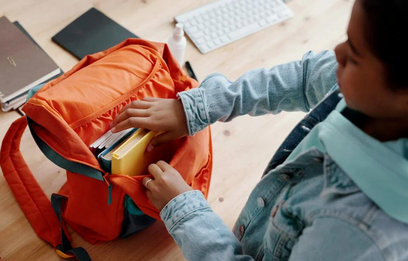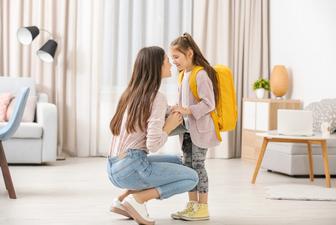|
The holidays can be so much fun for kids- they get to spend time with you, see extended family, play with new toys, bake cookies, and watch holiday movie faves! As a parent, it feels GREAT to know that your children are enjoying that special space you made for them.  But as the return to school looms ahead, it can bring up feelings of anxiety or dread for kids and teens. Watching your children struggle as they think about going back to school can be so hard. You can't magically erase your children’s worries (if only!), but you can give them coping tools to help ease their back-to-school anxiety. Strategies to Help Your Child Cope with Back-To-School AnxietyAs your child begins to open up about their back-to-school jitters, it can be SO tempting to reassure them with how much fun they’ll have on the first day back or how great school will be. All parents want to do this, because we love our kids and want them to feel happy! But in times of worry, it’s helpful to dial back your inner mama/papa bear instinct. Hearing constant assurances when feeling nervous can make kids feel misunderstood or like their worries don’t matter. Here are 5 steps of what you can do instead: 1. Validate Your Child’s Emotions
Share times when you or someone they know has felt nervous about coming back to something. ➡️ “I’m going back to work in a few days, and you know what? I’m feeling kinda nervous about that too.” ➡️ “Do you remember when Spider-Man rejoined the Avengers after fighting smaller criminals in New York? He seemed pretty nervous to go back.” 2. Gather Data about the Worry. Talk Back with Facts Talk to your child and try to gather specifics about their worry. Maintaining a gentle and curious tone is key! This is a collaborative process with your child - both of you are like archeologists, working to uncover the hidden causes of worry as a team, or alchemists, turning what-ifs (What if I miss my family? What if I get bad grades? What if I get nervous in front of my friends?) into information (I’m worried that I will be nervous in front of my friends, miss my family, and get bad grades). Here are some great questions to help uncover the important worry details:➡️ “Do you think something might go wrong? Tell me more about that.. ” ➡️ “What do you think might be hard?” ➡️ “If I were a fly in your brain and could see the thoughts zipping by, what would I be reading?” Make a list together; seeing worries laid out can make them feel smaller than when they’re running around in your child’s head. ➡️ “I wrote down that you’re nervous to be in Ms. Anderson’s class, eat the food from the cafeteria, and talk to George after you haven’t seen him in a while. Did we get that right?”  Once you’ve got the worry details clear, validate your child’s anxiety again. ➡️ “It sounds like you’re afraid that you’ll have to eat lunch alone (instead of with. me). It’s hard to be alone when it feels like everyone else is hanging out together.” ➡️ “You seem especially nervous about math class. Learning math can be really hard, and that can feel kinda stressful.” With the worry details in hand, the next step is to talk back to these worries with facts.Working collaboratively - help your child use data to poke holes in the worry story they’re feeling stuck on. Helping your child learn to challenge their worries is a very important skill that I break down in this blog post. 3. Take A Brave StepLook at the data that you’ve gathered together and brainstorm small steps towards facing the situation they’re nervous about. Here are some examples: ➡️ If your child is nervous about seeing and talking to their friends at school, have them invite a friend over or give them a video call. ➡️ If your child is worried about loud noises and big groups of people in crowded hallways, find a local event where they can do something they enjoy around a big group of others their age (local libraries are a great place to find these kinds of activities, especially on short notice). ➡️ If your child is anxious about assignments or tests, review some school work together, ask them questions about subjects they understand - you could even have a mock-school-day where you teach them about something fun at home! Once they practice taking their brave step, ask them how they feel. Was it as hard as they thought it would be? What did they enjoy about it? Give them a chance to REFLECT on the experience. As your child practices taking brave steps, show them you’re proud of them! A high-five, some words of encouragement - whatever feels right to you. They took a difficult step to do something they were afraid of! Express your pride in them for getting through it, and that will model for them that they should be proud of themselves, too. Taking small steps toward facing the feared situation will help them feel confident about taking their next brave step. 4. Model Coping with UncertaintyAs you and your child use tools and take actions together, they will learn how to COPE with anxiety - not sweep it under the rug, but face it head-on. Learning to take those brave steps is so important, but there’s another critical component: Accepting uncertainty. It is so powerful to show children that sometimes we don’t know always what’s going to happen… and that’s okay! ➡️ “When we visited Grandma last week, we made lots of great plans, but we didn't know exactly how they would go and some plans changed! We also can’t know how the first day back at school will go, and that’s ok” ➡️ “When I go back to work next week, I have a big presentation that I’m nervous about. I’ve practiced a lot, but I can’t know for sure how well I will do or what people will think.” Once you’ve labeled the uncertainty, let your child know - You can handle this!Here’s a few ideas for how to do that:  ➡️ Words of confidence: “You’ve got this.” ➡️ Remind them they’re not alone in this: “...even though lots of people feel nervous about going back to something, lots of people make it through” ➡️ Reminders of what they’re capable of: “...you already did a great job taking a brave step by inviting Jordan over.” ➡️ Point out things we know: “...at the end of the school day, you and I will go and get ice cream, no matter what!” 5. Make A Plan For Getting Back To SchoolAs the winter break winds down, you and your child can brainstorm something enjoyable to do on the first few days back at school. Here’s what it might look like to plan things to look forward to: ➡️ Monday: Bring new Spider-Man lunchbox to school ➡️ Tuesday: Get ice-cream sandwiches after school ➡️ Wednesday: Head to the playground after school with a friend While making this calendar together, encourage your child to write names or draw pictures of people at school they will be happy to see. Together, you can think about things your child can share with these people. Having conversation ideas in their back-pocket to fall back on can be really helpful (Show Mariah my new Pokemon cards! Tell Mr. Garcia about my epic Hot Wheels races!). Anxiety Coping Tools Today Sets Your Child Up For Success LaterThese 5 steps won’t make your child’s anxiety instantly go away; that’s just not how anxiety works. But taking steps today to give your child coping strategies to deal with anxiety will help them feel more confident about facing their fears, which sets them up for healthy coping in the future. Here is quick recap of the 5 steps to help your child cope with Back-to-School Anxiety:
As your child faces new situations at home and at school, they’ll have opportunities to use these tools and feel more confident with them. Most importantly, these strategies will help them gradually face their fears head-on so that even when anxiety shows up, it won’t hold them back from living full and meaningful lives! Working with a Therapist to Help Your Child Cope with Anxiety
Comments are closed.
|
Dr. Penela proudly provides evidence-based therapy services in English and Spanish. In-person appointments available in South Florida: Weston, Pembroke Pines, Miramar, Davie, Cooper City, Parkland, Hollywood, Fort Lauderdale, Plantation, and surrounding areas.
Tele-health sessions available to individuals residing in all 39 PSYPACT participating states, including Florida.
Tele-health sessions available to individuals residing in all 39 PSYPACT participating states, including Florida.
© 2020 - 2024 Wellness in Broward




